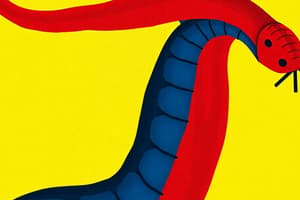Podcast
Questions and Answers
What is the primary method used to remove the adult Guinea worm from the body?
What is the primary method used to remove the adult Guinea worm from the body?
- Diethylcarbamazine administration
- Rolling the worm around a small stick (correct)
- Surgical extraction under anesthesia
- Application of topical antibacterial ointment
What symptoms are associated with Guinea worm infection when the female worm releases its toxic substances?
What symptoms are associated with Guinea worm infection when the female worm releases its toxic substances?
- Headaches, nausea, and dehydration
- Rashes, joint pain, and respiratory distress
- Diarrhea, cough, and fatigue
- Blisters, fever, and urticaria (correct)
What is the length of the larva of the Guinea worm?
What is the length of the larva of the Guinea worm?
- 400-500 m
- 700-900 m
- 500-700 m (correct)
- 250-300 m
Which of the following hosts is considered an intermediate host for the Guinea worm?
Which of the following hosts is considered an intermediate host for the Guinea worm?
Which form of Trichinella is primarily associated with domestic pigs?
Which form of Trichinella is primarily associated with domestic pigs?
What is a significant consequence of ruptured blisters from Guinea worm infection?
What is a significant consequence of ruptured blisters from Guinea worm infection?
What type of organism is Trichinella species classified as?
What type of organism is Trichinella species classified as?
Which feature distinguishes the male Trichinella from the female?
Which feature distinguishes the male Trichinella from the female?
Flashcards
Guinea Worm Habitat
Guinea Worm Habitat
Shallow ponds and open wells used for drinking water.
Guinea Worm Morphology
Guinea Worm Morphology
Adult is white, smooth, and up to a meter long; female. The male is smaller and dies after fertilization.
Guinea Worm Larva
Guinea Worm Larva
Large (500-700 mm), with a rounded head and long tail; may be coiled or uncoiled.
Guinea Worm Intermediate Host
Guinea Worm Intermediate Host
Signup and view all the flashcards
Trichinella Species Distribution
Trichinella Species Distribution
Signup and view all the flashcards
Trichinella Female Morphology
Trichinella Female Morphology
Signup and view all the flashcards
Guinea Worm Symptoms
Guinea Worm Symptoms
Signup and view all the flashcards
Trichinella Species Infections
Trichinella Species Infections
Signup and view all the flashcards
Study Notes
Guinea Worm (Dracunculus medinensis)
- Distribution: Found in areas where communities use shallow ponds or open wells for drinking water
- Adult Morphology: White, smooth surface; female is very long (up to one meter), male dies after fertilizing female
- Habitat: Subcutaneous tissue of lower limbs
- Larva: Large (500-700mm), rounded anterior end, pointed tail. Can be seen coiled or uncoiled in wet preparations.
- Intermediate Host: Cyclops, live in water. Infection occurs when humans drink water containing these infected copepods.
- Life Cycle: Larvae penetrate the host's stomach and intestinal wall, mature, and reproduce. Fertilized female worm emerges from skin after one year. L1 larvae are released into water from the emerging female.
- Pathology and Symptoms:
- Inflammatory reaction (blister) at skin site when female emerges.
- Secondary infections (abscesses, ulceration, necrosis, cellulitis, septicemia) can occur when blisters contact cold water and rupture
- Other symptoms: urticaria, erythema, vomiting, fever
- Diagnosis:
- Difficult: larvae often washed away into water
- Diagnosis is usually made when blister ruptures, exposing the anterior end of the female
- Can also use a few drops of water on ulcer to encourage larva discharge and examine it microscopically.
- Treatment: Carefully roll the worm around a stick and slowly pull it out of the skin
Trichinella Species
- Species:
- T. spiralis: Infects domestic pigs, rats, cats, and dogs
- T. nativa: Infects all carnivores
- T. nelsoni: Infects carnivores and wild pigs
- Distribution: Africa, Asia, and America
- Adult Morphology:
- Female: White, very small (4mm long), bluntly rounded posterior end, single ovary opening halfway down the body.
- Male: Small (1.5mm), curved posterior end, lobular appendages
- Habitat: Small intestine
- Larva: Coiled within lemon-shaped cysts, lie longitudinally along muscle fibres. Calcified larvae appear black.
- Life Cycle:
- Direct life cycle: Definitive host is pigs; accidental host (dead end) is humans.
- Infective form: Encysted larvae in muscle
- Infection: Ingestion of raw or undercooked infected meat containing encysted larvae (L1).
- Pathology and Symptoms: Typically mild; severe cases can cause: fever, chills, facial swelling, joint and muscle aches, rash
- Diagnosis:
- Muscle biopsy (direct or digestion technique)
- Intra-dermal tests, Bachmann skin test
- Stool examination (adult presence in severe diarrhea)
- Xenodiagnosis
- Serology (ELISA, Latex agglutination test)
Studying That Suits You
Use AI to generate personalized quizzes and flashcards to suit your learning preferences.




